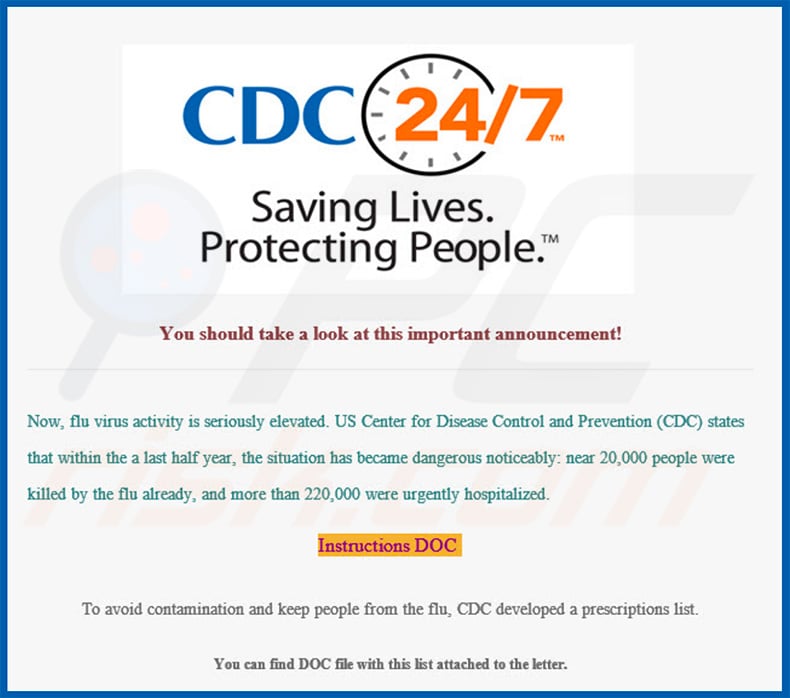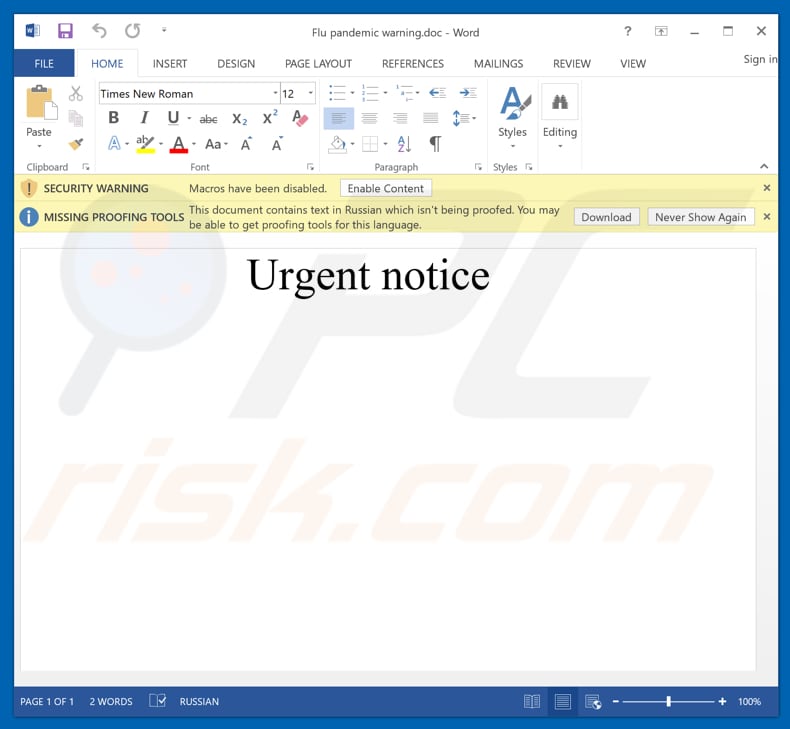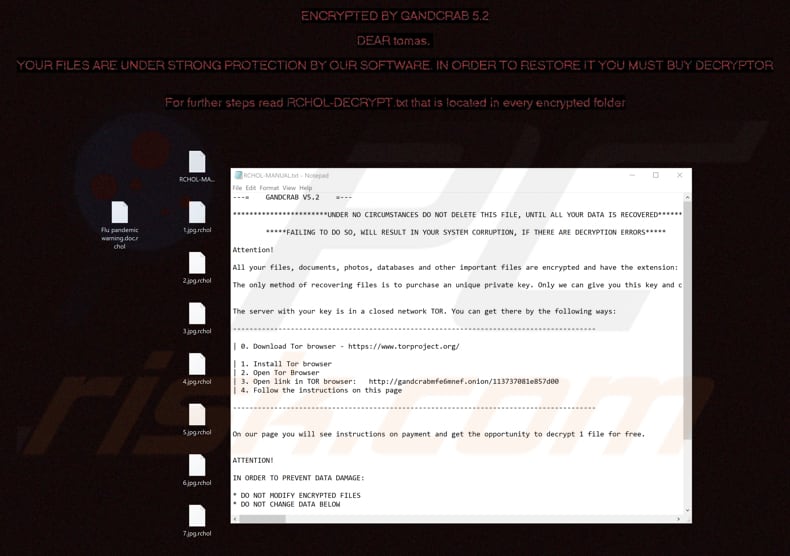Centers For Disease Control And Prevention Email Virus
Phishing/ScamAlso Known As: Centers For Disease Control And Prevention spam
Get free scan and check if your device is infected.
Remove it nowTo use full-featured product, you have to purchase a license for Combo Cleaner. Seven days free trial available. Combo Cleaner is owned and operated by RCS LT, the parent company of PCRisk.com.
What is "Centers for Disease Control and Prevention Email Virus"?
There are many spam email campaigns used on the internet. Cyber criminals send emails to infect users' computers with malicious programs.
"Centers for Disease Control and Prevention Email Virus" is just one example. It contains a link leading to a malicious attachment that infects computers with the Gandcrab 5.2 ransomware-type program. Once the attachment is opened, it downloads and installs the aforementioned computer infection.

This email is presented as an important warning about a flu pandemic from the US Center for Disease Control and Prevention (CDC). It states that currently there is a high risk of a flu virus and that nearly 20,000 people have already died as a result (and more than 220,000 were hospitalized).
To avoid this infection, people are urged to click the web link ("Instructions DOC") that, as stated in the email, opens a prescriptions list. Note, however, that this link will download and open a malicious Microsoft Word document called "Flu pandemic warning.doc". This document downloads and installs Gandcrab 5.2 ransomware.
Gandcrab 5.2 is a malicious program that, once installed, encrypts data stored on a computer and keeps it in this state until a ransom is paid. Therefore, victims cannot access their files without paying a specific sum in a cryptocurrency. The initial cost of a decryption tool is $1200, however, this might be increased.
All ransomware-type programs are categorized as high-risk computer infections. People with computers infected by these programs often experience data or financial loss. Therefore, do not open the link or attachment presented in the "Centers for Disease Control and Prevention Email Virus" email (scam).
| Name | Centers For Disease Control And Prevention spam |
| Threat Type | Ransomware, Crypto Virus, Files locker |
| Symptoms | Can't open files stored on your computer, previously functional files now have a different extension, for example my.docx.locked. A ransom demanding message is displayed on your desktop. Cyber criminals are asking to pay a ransom (usually in bitcoins) to unlock your files. |
| Distribution methods | Infected email attachments (macros), torrent websites, malicious ads. |
| Damage | All files are encrypted and cannot be opened without paying a ransom. Additional password stealing trojans and malware infections can be installed together with a ransomware infection. |
| Malware Removal (Windows) |
To eliminate possible malware infections, scan your computer with legitimate antivirus software. Our security researchers recommend using Combo Cleaner. Download Combo CleanerTo use full-featured product, you have to purchase a license for Combo Cleaner. 7 days free trial available. Combo Cleaner is owned and operated by RCS LT, the parent company of PCRisk.com. |
Most emails of this type are presented as official and legitimate. To achieve this, cyber criminals often use the names of well-known companies. Some examples of other spam campaigns that scammers use to distribute attachments and infect computers include "Confirm Bank Account Email Virus", "Sendinc Email Virus", and "O2 Bill Email Virus".
Generally, these infections are caused when people open links or attachments. Many malicious programs are proliferated through spam campaigns similar to this one including, for example, Adwind, Pony, FormBook, and TrickBot. Cyber criminals mostly use them to steal information (i.e. banking details) and generate revenue from it.
How did "Centers for Disease Control and Prevention Email Virus" infect my computer?
For a computer to become infected with the "Centers for Disease Control and Prevention Email Virus" scam, it is first necessary to open the "Instructions DOC" link. Once opened, it downloads and opens a malicious Microsoft Word document ("Flu pandemic warning.doc").
If opened with a newer version of Microsoft Office (2010 and later), it will ask to enable macros commands (effectively, to disable "Protected View" mode).
Enabling these commands will give this malicious document permission to download and install Gandcrab 5.2 ransomware. Other spam campaigns are used to infect computers in a similar way. In any case, the link or attachment presented in the email must first be opened for the virus to infiltrate.
How to avoid installation of malware?
Emails that contain web links or attachments should be carefully studied, especially if the emails are received from unknown, suspicious addresses. Note, they are often presented as official messages, however, the companies whose names are used have nothing to do with these emails.
Do not download software from unofficial websites, using third party downloaders, various Peer-to-Peer networks (torrent clients, eMule), and other similar channels/sources. The safest way to download software is using official websites and direct links.
Avoid using tools that activate paid software free of charge ("cracking tools") - they are illegal and they often cause computer infections. Having a reputable anti-virus or anti-spyware suite installed can detect and remove various threats (computer infections) before they can do any damage.
If you have already opened the "Centers for Disease Control and Prevention Email Virus" attachment, we recommend running a scan with Combo Cleaner Antivirus for Windows to automatically eliminate infiltrated malware.
Text presented in the "Centers for Disease Control and Prevention Email Virus" email message:
Subject: Flu pandemic warning.
You should take a look at this important announcement!
Now, flu virus activity is seriously elevated. US Center for Disease Control and Prevention (CDC) states that within the a last half year, the situation has became dangerous noticeably: near 20,000 people were killed by the flu already, and more than 220,000 were urgently hospitalized.
Instructions DOC
To avoid contamination and keep people from the flu, CDC developed a prescriptions list.
You can find DOC file with this list attached to the letter.
It is strongly recommended to study it with care and follow the directions to avoid the disease. With care of your health, CDC Communication Department
Not interested anymore? Unsubscribe
?© 2001??ì2019 All rights Reserved.
Malicious attachment distributed via "Centers for Disease Control and Prevention Email Virus" spam campaign:

Screenshot of files encrypted by Gandcrab 5.2 (and associated ransom message):

Instant automatic malware removal:
Manual threat removal might be a lengthy and complicated process that requires advanced IT skills. Combo Cleaner is a professional automatic malware removal tool that is recommended to get rid of malware. Download it by clicking the button below:
DOWNLOAD Combo CleanerBy downloading any software listed on this website you agree to our Privacy Policy and Terms of Use. To use full-featured product, you have to purchase a license for Combo Cleaner. 7 days free trial available. Combo Cleaner is owned and operated by RCS LT, the parent company of PCRisk.com.
Quick menu:
- What is Centers For Disease Control And Prevention spam?
- Types of malicious emails.
- How to spot a malicious email?
- What to do if you fell for an email scam?
Types of malicious emails:
![]() Phishing Emails
Phishing Emails
Most commonly, cybercriminals use deceptive emails to trick Internet users into giving away their sensitive private information, for example, login information for various online services, email accounts, or online banking information.
Such attacks are called phishing. In a phishing attack, cybercriminals usually send an email message with some popular service logo (for example, Microsoft, DHL, Amazon, Netflix), create urgency (wrong shipping address, expired password, etc.), and place a link which they hope their potential victims will click on.
After clicking the link presented in such email message, victims are redirected to a fake website that looks identical or extremely similar to the original one. Victims are then asked to enter their password, credit card details, or some other information that gets stolen by cybercriminals.
![]() Emails with Malicious Attachments
Emails with Malicious Attachments
Another popular attack vector is email spam with malicious attachments that infect users' computers with malware. Malicious attachments usually carry trojans that are capable of stealing passwords, banking information, and other sensitive information.
In such attacks, cybercriminals' main goal is to trick their potential victims into opening an infected email attachment. To achieve this goal, email messages usually talk about recently received invoices, faxes, or voice messages.
If a potential victim falls for the lure and opens the attachment, their computers get infected, and cybercriminals can collect a lot of sensitive information.
While it's a more complicated method to steal personal information (spam filters and antivirus programs usually detect such attempts), if successful, cybercriminals can get a much wider array of data and can collect information for a long period of time.
![]() Sextortion Emails
Sextortion Emails
This is a type of phishing. In this case, users receive an email claiming that a cybercriminal could access the webcam of the potential victim and has a video recording of one's masturbation.
To get rid of the video, victims are asked to pay a ransom (usually using Bitcoin or another cryptocurrency). Nevertheless, all of these claims are false - users who receive such emails should ignore and delete them.
How to spot a malicious email?
While cyber criminals try to make their lure emails look trustworthy, here are some things that you should look for when trying to spot a phishing email:
- Check the sender's ("from") email address: Hover your mouse over the "from" address and check if it's legitimate. For example, if you received an email from Microsoft, be sure to check if the email address is @microsoft.com and not something suspicious like @m1crosoft.com, @microsfot.com, @account-security-noreply.com, etc.
- Check for generic greetings: If the greeting in the email is "Dear user", "Dear @youremail.com", "Dear valued customer", this should raise suspiciousness. Most commonly, companies call you by your name. Lack of this information could signal a phishing attempt.
- Check the links in the email: Hover your mouse over the link presented in the email, if the link that appears seems suspicious, don't click it. For example, if you received an email from Microsoft and the link in the email shows that it will go to firebasestorage.googleapis.com/v0... you shouldn't trust it. It's best not to click any links in the emails but to visit the company website that sent you the email in the first place.
- Don't blindly trust email attachments: Most commonly, legitimate companies will ask you to log in to their website and to view any documents there; if you received an email with an attachment, it's a good idea to scan it with an antivirus application. Infected email attachments are a common attack vector used by cybercriminals.
To minimise the risk of opening phishing and malicious emails we recommend using Combo Cleaner Antivirus for Windows.
Example of a spam email:

What to do if you fell for an email scam?
- If you clicked on a link in a phishing email and entered your password - be sure to change your password as soon as possible. Usually, cybercriminals collect stolen credentials and then sell them to other groups that use them for malicious purposes. If you change your password in a timely manner, there's a chance that criminals won't have enough time to do any damage.
- If you entered your credit card information - contact your bank as soon as possible and explain the situation. There's a good chance that you will need to cancel your compromised credit card and get a new one.
- If you see any signs of identity theft - you should immediately contact the Federal Trade Commission. This institution will collect information about your situation and create a personal recovery plan.
- If you opened a malicious attachment - your computer is probably infected, you should scan it with a reputable antivirus application. For this purpose, we recommend using Combo Cleaner Antivirus for Windows.
- Help other Internet users - report phishing emails to Anti-Phishing Working Group, FBI’s Internet Crime Complaint Center, National Fraud Information Center and U.S. Department of Justice.
Share:

Tomas Meskauskas
Expert security researcher, professional malware analyst
I am passionate about computer security and technology. I have an experience of over 10 years working in various companies related to computer technical issue solving and Internet security. I have been working as an author and editor for pcrisk.com since 2010. Follow me on Twitter and LinkedIn to stay informed about the latest online security threats.
PCrisk security portal is brought by a company RCS LT.
Joined forces of security researchers help educate computer users about the latest online security threats. More information about the company RCS LT.
Our malware removal guides are free. However, if you want to support us you can send us a donation.
DonatePCrisk security portal is brought by a company RCS LT.
Joined forces of security researchers help educate computer users about the latest online security threats. More information about the company RCS LT.
Our malware removal guides are free. However, if you want to support us you can send us a donation.
Donate
▼ Show Discussion